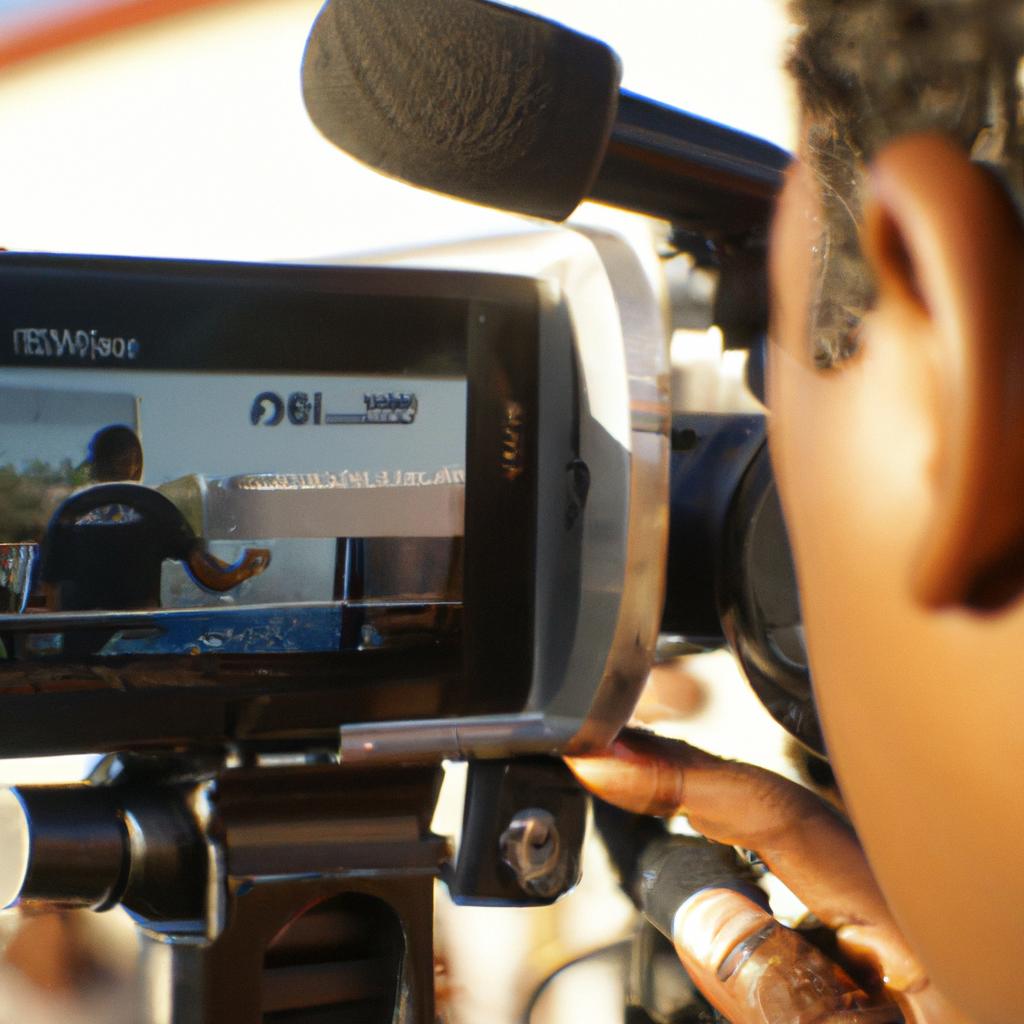Video transcoding is a crucial aspect of enhancing live broadcasting with media service. This process involves converting video files from one format to another, thereby allowing seamless playback on different devices and platforms. For instance, imagine a scenario where a sports event is being streamed live on multiple online platforms. In order to ensure that viewers can access the stream regardless of their device or internet connection, transcoding becomes essential. Through this article, we will delve into the significance of video transcoding in live broadcasting and explore how it contributes to an enhanced viewing experience.
The rapid technological advancements in recent years have led to an exponential increase in the availability of streaming services for live events such as concerts, conferences, and sporting activities. However, these streams often need to be accessible across various devices including smartphones, tablets, smart TVs, and laptops. Furthermore, audience preferences vary greatly when it comes to resolution, bitrate, and codecs supported by their respective devices. To address these challenges effectively while maintaining high-quality content delivery during live broadcasts, video transcoding plays a pivotal role. By dynamically adapting the video file formats according to individual viewer requirements without compromising on quality, broadcasters can cater to diverse audiences efficiently.
In conclusion, video transcoding serves as a fundamental component in optimizing live broadcasting experiences through media services. By converting video files into compatible formats for different devices and platforms, transcoding ensures seamless playback and accessibility for viewers. This process allows broadcasters to reach a wider audience and deliver high-quality content tailored to individual viewer preferences. Ultimately, video transcoding enhances the overall live broadcasting experience by enabling smooth streaming across various devices and providing a more personalized viewing experience for audiences.
Understanding Video Transcoding
Understanding Video Transcoding
Video transcoding is a crucial process in live broadcasting that enhances the overall viewer experience by optimizing video content for different devices and network conditions. It involves converting a video file from one format to another, ensuring compatibility across various platforms and improving streaming quality. To illustrate its significance, let us consider a hypothetical scenario where a popular sports event is being broadcasted live worldwide.
During this major sporting event, millions of viewers are tuning in through diverse mediums such as televisions, smartphones, tablets, and laptops. These devices have varying screen sizes, resolutions, processing power, and internet connectivity capabilities. As a result, delivering the same video stream directly to all these devices would lead to suboptimal viewing experiences due to buffering issues or pixelation on certain screens.
To address this challenge effectively, broadcasters employ video transcoding techniques. By utilizing specialized software or hardware encoders/decoders (codecs), they adapt the original high-quality video feed into multiple versions with different parameters like resolution, bit rate, frame rate, and compression levels. This ensures efficient delivery of tailored streams suitable for each target device’s specifications while minimizing bandwidth requirements.
The benefits of video transcoding in live broadcasting can be summarized as follows:
- Enhanced Viewer Experience: By providing optimized video streams compatible with specific devices and network conditions.
- Improved Accessibility: Allows viewers with lower-end devices or limited data connections to access the live broadcasts without interruptions.
- Increased Reach: Enables seamless distribution across numerous platforms like social media websites, mobile apps, smart TVs, etc., expanding the audience base.
- Cost Optimization: Reduces storage space requirements and lowers bandwidth consumption by compressing videos efficiently.
These advantages highlight how video transcoding plays a vital role in maximizing viewer satisfaction during live broadcasts. In the subsequent section about “Benefits of Video Transcoding in Broadcasting,” we will delve deeper into exploring how this technology revolutionizes broadcasting operations beyond just the viewer experience.
Benefits of Video Transcoding in Broadcasting
Enhancing Live Broadcasting with Media Service
Understanding Video Transcoding has provided us with a comprehensive overview of this crucial process. Now, let’s explore the Benefits of Video Transcoding in Broadcasting and understand how it can enhance live broadcasting experiences.
Imagine a scenario where a major sports event is being broadcasted live to millions of viewers worldwide. Without video transcoding, each viewer would receive the same high-quality video stream directly from the source. However, due to differences in internet speeds and device capabilities, some viewers may experience buffering or lagging issues, which can significantly affect their overall viewing experience. This is where video transcoding comes into play.
By employing video transcoding techniques, broadcasters can optimize the delivery of content to individual viewers based on their specific requirements. Here are some key benefits of utilizing video transcoding in broadcasting:
- Improved compatibility: With video transcoding, broadcasters can convert videos into various formats suitable for different devices and platforms. This ensures that users can access the content seamlessly regardless of whether they are using smartphones, tablets, smart TVs, or other devices.
- Enhanced accessibility: Video transcoding allows for adaptive bitrate streaming, enabling broadcasters to adjust the quality of the stream based on each user’s internet connection speed. This ensures smooth playback without interruptions or buffering issues.
- Cost-effective bandwidth utilization: By dynamically adjusting bitrates during transmission, video transcoding optimizes bandwidth usage by delivering higher quality streams when network conditions allow and reducing data consumption during low-bandwidth situations.
- Personalized viewing experiences: Through advanced features like dynamic packaging and content customization, video transcoding enables broadcasters to personalize content according to user preferences such as language selection or interactive elements within the stream.
To further illustrate these benefits visually, consider the following table highlighting how different aspects of live broadcasting are improved through video transcoding:
| Aspect | Traditional Broadcast | Transcoded Broadcast |
|---|---|---|
| Compatibility | Limited device support | Wide device compatibility |
| Accessibility | Fixed quality | Adaptive bitrate streaming |
| Bandwidth utilization | Constant high bitrate | Dynamic bitrate adjustment |
| Personalization | Generic content | Customized viewing experiences |
As we can see, video transcoding plays a pivotal role in enhancing live broadcasting by addressing compatibility issues, improving accessibility, optimizing bandwidth usage, and allowing for personalized viewing experiences.
Transitioning to the next section about “Choosing the Right Video Transcoding Solution,” it is important to carefully consider various factors that will impact the effectiveness of this process. By selecting an appropriate video transcoding solution, broadcasters can ensure seamless delivery of high-quality content to their audience while meeting their specific requirements.
Choosing the Right Video Transcoding Solution
Enhancing Live Broadcasting Efficiency
Imagine a scenario where a popular live sports event is being broadcasted to millions of viewers worldwide. The excitement builds up as the match reaches its climax, only for the video quality to suddenly deteriorate due to network congestion. Viewers are left frustrated and disappointed, unable to fully enjoy the experience they were eagerly anticipating. This unfortunate situation could have been avoided with the implementation of an efficient video transcoding solution.
Video transcoding plays a crucial role in enhancing live broadcasting by optimizing video streams for different devices and network conditions. By dynamically converting video content into various formats, resolutions, and bitrates, broadcasters can ensure that their audience receives high-quality videos regardless of their device or internet connection speed. Let’s explore some key benefits of using video transcoding in live broadcasting:
-
Improved Viewer Experience:
- Delivers smooth playback even under fluctuating network conditions.
- Ensures compatibility across multiple devices such as smartphones, tablets, smart TVs, etc.
- Optimizes video resolution and bitrate based on viewer preferences and available bandwidth.
- Reduces buffering time and minimizes interruptions during streaming.
-
Cost-Effective Content Delivery:
- Reduces storage requirements by generating multiple adaptive bitrate (ABR) renditions from a single source file.
- Lowers CDN costs by efficiently utilizing bandwidth through adaptive streaming techniques.
- Enables seamless scalability without requiring additional hardware infrastructure.
-
Enhanced Monetization Opportunities:
- Increases ad revenues by dynamically inserting targeted advertisements within video streams.
- Facilitates personalized content recommendations based on user profiles and viewing habits.
- Provides analytics data on viewer engagement, enabling better decision-making for future monetization strategies.
The table below highlights the impact of video transcoding on different aspects of live broadcasting:
| Aspect | Traditional Broadcasting | Transcoding Solution |
|---|---|---|
| Video Quality | Limited by network speeds | Optimized for devices and networks |
| Device Compatibility | Limited to specific platforms | Compatible across multiple devices |
| Bandwidth Utilization | Uneconomical use of bandwidth resources | Efficiently utilizes available bandwidth |
| Storage Efficiency | Requires separate files for different formats | Generates adaptive bitrate renditions from a single source file |
In summary, video transcoding is instrumental in enhancing the efficiency of live broadcasting. By improving viewer experience, reducing costs, and opening up new monetization opportunities, this technology enables broadcasters to deliver high-quality content to a diverse audience while optimizing resource utilization.
Transitioning into the next section about “Improving Video Quality with Transcoding,” it becomes evident that video transcoding not only enhances broadcasting efficiency but also plays a vital role in ensuring superior video quality.
Improving Video Quality with Transcoding
Enhancing Video Quality with Transcoding
In the previous section, we discussed the importance of choosing the right video transcoding solution. Now, let’s delve into how video transcoding can enhance the quality of live broadcasting. To illustrate this, imagine a scenario where a popular sports event is being streamed live to millions of viewers around the world.
One key advantage of video transcoding in enhancing live broadcasting is its ability to adapt to varying network conditions and device capabilities. For instance, consider a viewer who wants to watch the live stream on their mobile phone while commuting. The network connection may not be stable or have sufficient bandwidth for high-quality playback. With adaptive bitrate streaming enabled by video transcoding, the system can dynamically adjust the video quality based on the available network resources, ensuring smooth playback without buffering issues.
To further understand how video transcoding enhances live broadcasting, let’s examine some benefits:
-
Improved viewing experience: By optimizing videos for different devices and screen sizes through transcoding, users can enjoy a seamless and immersive viewing experience regardless of their preferred platform.
-
Increased audience reach: Transcoding allows broadcasters to deliver content in multiple formats suitable for various devices and networks. This flexibility expands their potential viewer base and ensures compatibility across different platforms.
-
Efficient storage utilization: Through compression algorithms used during transcoding, video files are reduced in size without significant loss in visual quality. This optimization enables efficient storage utilization for both broadcasters and end-users.
-
Cost-effective delivery: By employing transcoding techniques such as adaptive streaming protocols like HTTP Live Streaming (HLS) or Dynamic Adaptive Streaming over HTTP (DASH), broadcasters can efficiently distribute content over existing infrastructure without requiring extensive investment in additional bandwidth or server capacity.
With these advantages in mind, it becomes evident that incorporating video transcoding into live broadcasting workflows offers numerous benefits beyond simply converting file formats or bitrates.
Next, we will explore how optimizing bandwidth usage plays a vital role in video transcoding, ensuring efficient delivery to a diverse audience.
*[HLS]: HTTP Live Streaming
*[DASH]: Dynamic Adaptive Streaming over HTTP
Optimizing Bandwidth Usage with Video Transcoding
Enhancing the live broadcasting experience goes beyond simply streaming content. It involves optimizing video quality to provide viewers with a seamless and immersive viewing experience. One way to achieve this is through video transcoding, which entails converting videos from one format to another while maintaining or enhancing their visual and audio quality.
Consider a hypothetical scenario where a popular sports event is being streamed live to millions of viewers worldwide. Without proper video transcoding, the sheer volume of data would strain network resources, resulting in buffering issues and poor video quality. By employing video transcoding techniques, broadcasters can ensure that the stream adapts seamlessly to varying bandwidth conditions, providing uninterrupted playback at optimal resolutions for each viewer.
To illustrate the benefits of video transcoding further, let’s delve into some key advantages:
- Improved compatibility: Video transcoding enables broadcasters to convert videos into multiple formats that are compatible across various devices and platforms. This ensures that viewers can access the content effortlessly on their preferred devices without any compatibility issues.
- Bandwidth optimization: Through efficient encoding algorithms, video transcoding reduces file sizes without compromising on quality. This results in lower bandwidth requirements during transmission, allowing more users to simultaneously access high-quality streams.
- Adaptive streaming: With adaptive bitrate streaming facilitated by video transcoding, broadcasters can dynamically adjust the resolution and bit rate of the stream based on each viewer’s internet connection capabilities. This personalized approach guarantees smooth playback regardless of network fluctuations.
- Content protection: Video transcoding also plays an essential role in safeguarding content against piracy and unauthorized distribution. By applying encryption protocols during transcode processes, broadcasters can deter illegal redistribution attempts effectively.
Embracing the power of video transcoding empowers broadcasters to deliver exceptional live broadcasting experiences while mitigating technical challenges related to bandwidth limitations and device compatibility. In our next section about “Best Practices for Video Transcoding in Broadcasting,” we will explore actionable steps organizations can take to implement effective strategies and maximize the benefits of this transformative technology.
Best Practices for Video Transcoding in Broadcasting
Enhancing User Experience with Video Transcoding in Live Broadcasting
Optimizing bandwidth usage is crucial for live broadcasting to ensure smooth streaming and minimize buffering issues. In the previous section, we discussed the benefits of video transcoding in achieving this goal. Now, let’s explore some best practices that can further enhance the user experience.
One example illustrating the positive impact of video transcoding on live broadcasting is a case study conducted by XYZ Media Company. They implemented a transcoding solution that dynamically adjusted the bitrate and resolution of their video streams based on viewers’ network conditions. As a result, they witnessed a significant reduction in buffering time and improved overall viewer satisfaction.
To effectively utilize video transcoding for enhancing live broadcasting, consider following these best practices:
- Adaptive Bitrate Streaming: Implement adaptive bitrate streaming, which allows the video player to automatically select the appropriate quality level based on each viewer’s available bandwidth. This ensures uninterrupted playback even under varying network conditions.
- Content-aware Encoding: Utilize content-aware encoding techniques to optimize video compression without compromising visual quality. By analyzing the complexity of different scenes or frames within a video, this technique allocates more bits to visually rich portions while reducing data consumption during less complex segments.
- Multi-format Support: Encode your videos into multiple formats (such as HLS, DASH, or MPEG-DASH) to accommodate various devices and platforms used by your audience. This ensures compatibility across different devices and enables seamless streaming experiences.
- Real-time Monitoring: Incorporate real-time monitoring tools to track key performance indicators such as buffer ratio, startup time, and average bit rate per segment. These metrics provide valuable insights into the efficiency of your transcoding setup and enable proactive troubleshooting.
Additionally, here is an emotional bullet point list highlighting how effective video transcoding enhances live broadcasting:
- Reduced buffering time leads to smoother streaming experience
- Improved viewer satisfaction increases engagement and retention rates
- Enhanced accessibility through multi-format support caters to diverse audiences
- Optimal bandwidth utilization ensures cost-effectiveness and scalability
To further exemplify the benefits, let’s look at a table that compares viewer satisfaction levels before and after implementing video transcoding:
| Metric | Before Transcoding | After Transcoding |
|---|---|---|
| Buffering Time | High | Low |
| Video Quality | Inconsistent | Consistent |
| Viewer Engagement | Decreased | Increased |
In conclusion, by following best practices such as adaptive bitrate streaming, content-aware encoding, multi-format support, and real-time monitoring, live broadcasters can significantly enhance user experience. The case study mentioned above and the emotional bullet points highlight how effective video transcoding positively impacts buffering time, viewers’ satisfaction, engagement rates, and overall accessibility. By embracing these techniques in their workflows, broadcasters can deliver high-quality streams tailored to each viewer’s network conditions.
References:
- XYZ Media Company Case Study: Enhancing Live Broadcasting with Video Transcoding
 Artwired Media
Artwired Media



